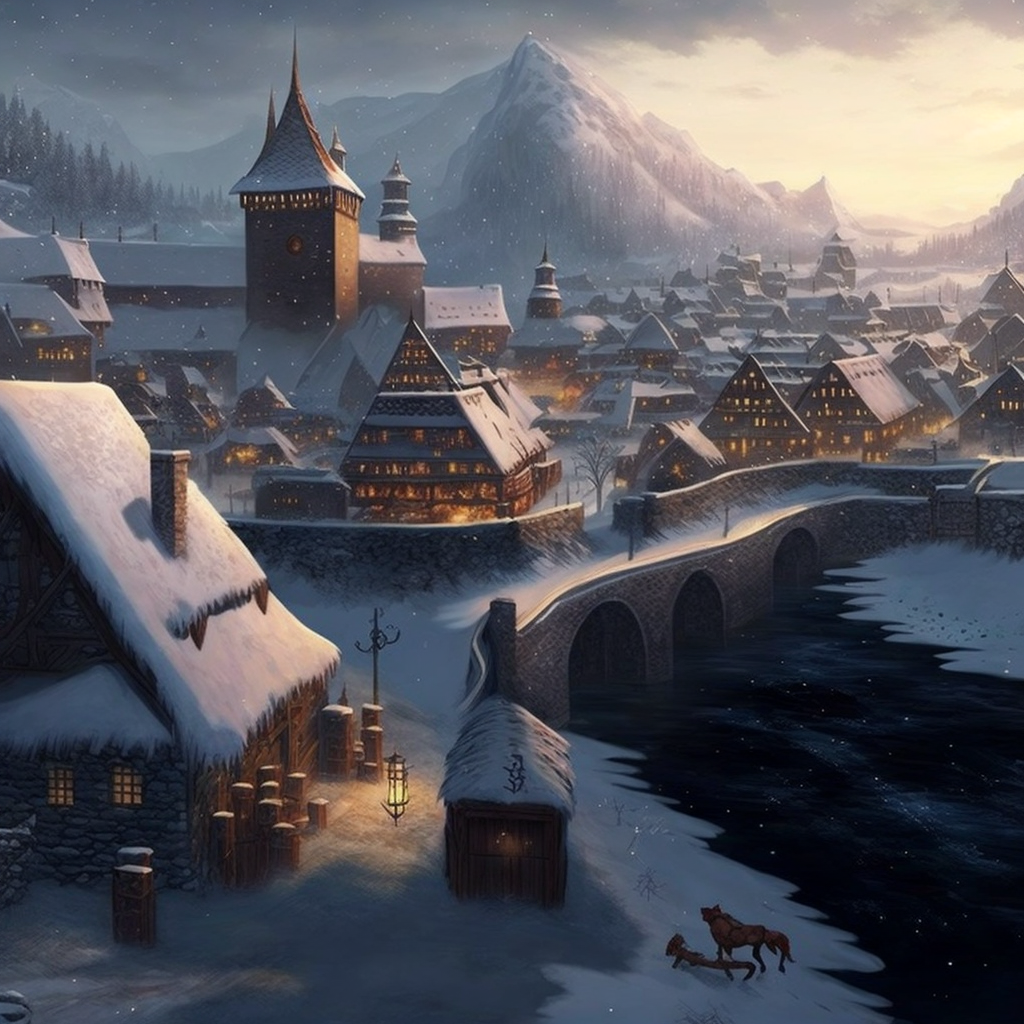Last Light
One of the most notable of the remaining cities, Last Light is the mythological epicentre of where humanity, elvenkind, and dwarvenkind stood together to reignite the dying sun, forever casting it red.
The city and immediate surround area holds a population of eleven thousand, making it the 4th most populous settlement in the The Kingdom of the Last Men , and the 5th most populous on the continent of Iserlohn.
Taverns
Temples
Demographics
Last Light is predominantly populated by humans, who make up the majority of the city's inhabitants. Other races such as dwarves, elves, and halflings also reside in the city, but in much smaller numbers. The dwarven population, in particular, is a significant minority, with many of them working in the city's mines and metalworking industries.
Despite the challenging living conditions, the people of Last Light are known for their resilience and resourcefulness. They have a strong sense of community and loyalty to their leaders, which is reflected in the way they work together to survive in the harsh environment. The city's population is made up of people from all walks of life, from farmers and craftsmen to soldiers and nobles.
Although the city has seen its fair share of conflict and hardship, its population remains diverse and vibrant. The people of Last Light take pride in their city and its rich history, and continue to work together to ensure its survival in the face of the unforgiving climate.
Government
The city of Last Light is ruled by the mighty and respected Lord Lufir Holden. However, for the majority of his rulings, he defers to his Advisor-in-Chief Yela Ironhand.
The Lord's power is exercised through a hierarchy of local nobles, who rule over smaller regions within the kingdom. These nobles owe their allegiance and military service to the Lord in exchange for land grants and other privileges. The Lord also employs a council of advisers, consisting of his most trusted vassals and representatives of the commoners, to assist him in making decisions and governing the realm.
The city of Last Light itself is governed by a council of aldermen known as the Council of Five, who are elected by the citizens of the city. The council holds responsibility for the administration of the city, including the maintenance of law and order, taxation, and public works.
This council was formed by Yela Ironhand around twenty years ago, and has served with some rotating members for the duration.
The Advisor - Yela Ironhand
The Merchant - Lady Elwen Lyadova
The Warrior - Marc Lentz
The Teacher - Mehran Mir
The Prophet - Aranthe Sulu
Overall, the government of Last Light is characterized by a complex system of overlapping and interdependent power structures, with the Lord, local nobles, and city council all playing important roles in the governance of the region.
Industry & Trade
Two large smithy's make business in Last Light, an old dwarven master craftsman, and a noble-born human with natural talent - but little experience. Several smaller blacksmiths operate in the city, but sell primarily to farmers and carpenters, with little-to-no experience working steel for weaponry.
The largest is owned by Balin Blackiron, As stubborn as he is true with his hammer, Balin makes good arms and armour - but little small talk. He charges a premium price for his wares, but all would agree on their value to an adventurer, or warrior, alike.
Despite being born of noble stock, the middle son of House Lanranth chose not a life of warmth around the hearth of the Great Lanranth Estate, but the heat of the forge in it's stead. Kal Lanranth tries to undercut Balin Blackiron on price, but fails to make up the same quality. Despite this, his work is quite popular with patrolmen and hunters looking for an upgrade from their usual gear.
Districts
Last Light is divided into several districts, each with its unique features and characteristics. The districts are primarily based on the city's topography and history.
The Old Town is the oldest district in Last Light and is the heart of the city's cultural and historical heritage. It is characterized by narrow streets, small alleys, and old buildings dating back to the early medieval era. Many of the city's historical landmarks, including the Last Light Cathedral and the Old Market, can be found in this district.
The Riverside district is located along the banks of the Last River, which runs through the city. It is a relatively newer district, with larger and more spacious buildings than the Old Town. The district is home to many warehouses and factories that use the river for transportation and trade. It is also a popular residential area for the city's working-class population.
The Market district is the commercial hub of Last Light, with many shops, markets, and businesses concentrated in the area. The district is located in the heart of the city and is bustling with activity, particularly during the day. It is also home to many of the city's administrative buildings, including the town hall and the central market.
The Castle district is where the Last Light Castle, the seat of Lord Lufir Holden, is located. It is a heavily fortified district with high walls and gates that separate it from the rest of the city. The district is also home to many of the city's wealthy and powerful families, who live in large mansions and estates.
Points of interest
The Crow and Crown Inn
Icepick Handshake Inn
The Old Head Inn
Farsign Inn
The Fang and Horn Tavern
Last Light has three commonly visited temples, with an additional temple located beneath Lord Holden's castle for private worship of an outlawed deity.
Church of Neptune
Neptune is a member of the major circle, a generally hands-off god, with the obvious domain of the sea and oceans. Commonly worshipped by sailors and merchants.
Like all other gods of the major circle, he has remained in a deep slumber for the past eon.
His temple still stands proud, maintained by a cohort of devout priests and monks. The temple is built of imported sandstone, with lapis lazuli accenting around it's elaborate masonry. It's doors are open all day and night, closing only for the spring tide, on which special rituals are carried out.
Temple of Sol
The Temple of Sol is the most popular site of worship in Last Light, no doubt due to the settlements close connection historically with the Battle for the Last Light.
Sol has slept since the beginning of time, having no domain, nor aspects. Yet without Sol, life would cease to be.
Sol's temple is grand and truly a masterwork of engineering for it's time. A grand entranceway leads into the main chamber, above which sits the Great Observatory. From the ceiling hangs a series of mirrors and lenses which focus the suns light down to a point behind the lectern, forcing worshippers to avert their eyes from the speaker.
Church of Kharon
The god of the dead, Kharon, is a member of the minor circle, and so is comparatively active for a god. Kharon fulfils his namesake's purpose and ferries the souls of the dead to their afterlife. And crucially, it is Kharon who settles the soul-debts of any of the deceased and delivers them to the realm of their new master.
Kharon's temple is modest, with a small space for worship and mourning. A larger space outside is used for funerals before the burning and burial of remains.
Founding Date
5E 8942 / 6E 0
Alternative Name(s)
Eärendil, Khazad-Khazael
Type
Large town
Population
14,388
Inhabitant Demonym
Lastlighters
Location under
Included Locations
Owner/Ruler
Additional Rulers/Owners
Owning Organization




